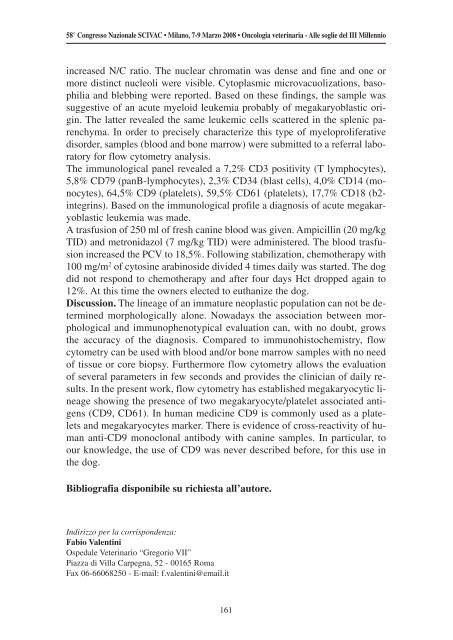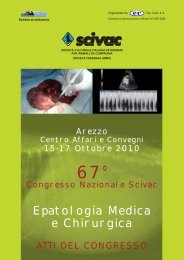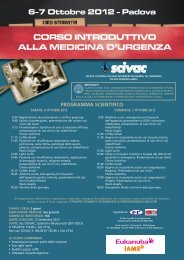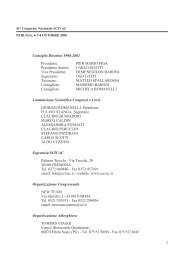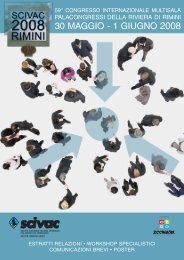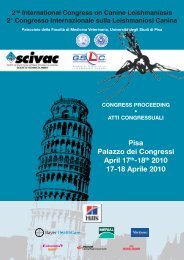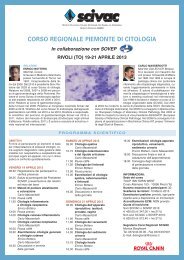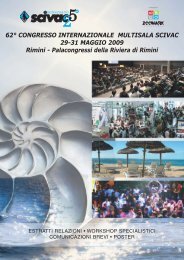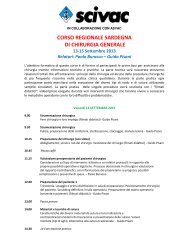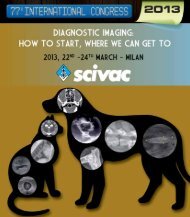58° Congresso Nazionale SCIVAC: Oncologia veterinaria
58° Congresso Nazionale SCIVAC: Oncologia veterinaria
58° Congresso Nazionale SCIVAC: Oncologia veterinaria
Create successful ePaper yourself
Turn your PDF publications into a flip-book with our unique Google optimized e-Paper software.
58° <strong>Congresso</strong> <strong>Nazionale</strong> <strong>SCIVAC</strong> • Milano, 7-9 Marzo 2008 • <strong>Oncologia</strong> <strong>veterinaria</strong> - Alle soglie del III Millennio<br />
increased N/C ratio. The nuclear chromatin was dense and fine and one or<br />
more distinct nucleoli were visible. Cytoplasmic microvacuolizations, basophilia<br />
and blebbing were reported. Based on these findings, the sample was<br />
suggestive of an acute myeloid leukemia probably of megakaryoblastic origin.<br />
The latter revealed the same leukemic cells scattered in the splenic parenchyma.<br />
In order to precisely characterize this type of myeloproliferative<br />
disorder, samples (blood and bone marrow) were submitted to a referral laboratory<br />
for flow cytometry analysis.<br />
The immunological panel revealed a 7,2% CD3 positivity (T lymphocytes),<br />
5,8% CD79 (panB-lymphocytes), 2,3% CD34 (blast cells), 4,0% CD14 (monocytes),<br />
64,5% CD9 (platelets), 59,5% CD61 (platelets), 17,7% CD18 (b2-<br />
integrins). Based on the immunological profile a diagnosis of acute megakaryoblastic<br />
leukemia was made.<br />
A trasfusion of 250 ml of fresh canine blood was given. Ampicillin (20 mg/kg<br />
TID) and metronidazol (7 mg/kg TID) were administered. The blood trasfusion<br />
increased the PCV to 18,5%. Following stabilization, chemotherapy with<br />
100 mg/m 2 of cytosine arabinoside divided 4 times daily was started. The dog<br />
did not respond to chemotherapy and after four days Hct dropped again to<br />
12%. At this time the owners elected to euthanize the dog.<br />
Discussion. The lineage of an immature neoplastic population can not be determined<br />
morphologically alone. Nowadays the association between morphological<br />
and immunophenotypical evaluation can, with no doubt, grows<br />
the accuracy of the diagnosis. Compared to immunohistochemistry, flow<br />
cytometry can be used with blood and/or bone marrow samples with no need<br />
of tissue or core biopsy. Furthermore flow cytometry allows the evaluation<br />
of several parameters in few seconds and provides the clinician of daily results.<br />
In the present work, flow cytometry has established megakaryocytic lineage<br />
showing the presence of two megakaryocyte/platelet associated antigens<br />
(CD9, CD61). In human medicine CD9 is commonly used as a platelets<br />
and megakaryocytes marker. There is evidence of cross-reactivity of human<br />
anti-CD9 monoclonal antibody with canine samples. In particular, to<br />
our knowledge, the use of CD9 was never described before, for this use in<br />
the dog.<br />
Bibliografia disponibile su richiesta all’autore.<br />
Indirizzo per la corrispondenza:<br />
Fabio Valentini<br />
Ospedale Veterinario “Gregorio VII”<br />
Piazza di Villa Carpegna, 52 - 00165 Roma<br />
Fax 06-66068250 - E-mail: f.valentini@email.it<br />
161


